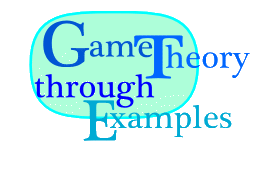
Applications

"To a man with a hammer everything looks like a nail"
Mark Twain
Remind the students about the two different tracks:
Strict rules, very often zero-sum games, strict mathematical treatment, limited scope,
versus real world applications with fuzzy and changing rules.
This is our first glimpse into real world. Later we will return in the advanced topics,
and in the projects
some of the students may dive deeper into this.
Game Theory is very successful when dealing with casino or parlor games like
chess, poker, black jack, and so on. These games have strict rules which have to be obeyed
totally, they are very often zero-sum and two-person, and very often allow a strict mathematical treatment.
In cases where a complete "solution" has not yet bee found, the difficulty mostly lies in the complexity
of the game---in principle we know how we would tackle the game, but the sheer size of the game
(of the normal form or the game digraph) lets even the fastest computers nowadays fail.
However, with advances in hardware, this may change soon.
However, von Neumann and Morgenstern were more ambitious with their book.
Their explicit aim was to provide a tool or framework
with which to attack less clearly-defined real-world "games" in economics, or
the social sciences. These situations are usually not zero-sum, the payoffs are more fuzzy,
and even the rules are not clearly defined at the beginning of the game. Creativity---the
ability to see other moves than those obvious---plays a big role. In the fifties, the US
government had very high hopes for Game Theory to provide concrete recommendations in
cold war situations, but this trust faded.
The advice stemming from game theoretical analysis of small and simple games is very often rather
obvious. If it is not, playing this counter-intuitive strategy computed through Game Theory
mostly doens't give the player an advantage.
What mostly remained from this first area of "looking for good nails for the game theory hammer"
was the classification of real-world situations.
2. Bending the Rules
One problem with applications in real world is that models mostly overemphasize
the rules---actually in game theory the rules are fixed, the number of moves are fixed and
known in advance.
In real world, you have always at least one more move than you think you have.
2.2 Threads and Promises
If you move second, it may still be possible to change the nature and the outcome of the game
by using threads or promises.
2.3. Commitment
..........
Thomas Schelling won the 2005 Nobel prize in economics
(shared with Robert J. Aumann).
His book "The Strategy of Conflict" was listed among the 100 most influential books since WWII
by the Times Literary Supplement. There he developed the framework of threads, promises, advantages
by restricting your moves (the Cortez example). He applied his theory to the cold war
threads with nuclear weapons.
According to Kaplan, Schelling provided the theoretical foundation to McNaughton
for the escalation of the Vietnam war (operation Rolling Thunder) in 1965.
His advice that the operation should not take longer than 3 weeks. After that time,
either the US had reached their goals, or would never reach them.
The operation lasted 3 years, however
[Kaplan 2005], [Schröder 2005].
More information on Schelling can be found on
pages of the University of Maryland
and .
Play the Universal Soldier by Donovan at the beginning of class. Crossing Borders Task---Ethics
Crossing Borders Task---Ethics: It was no coincidence that Game Theory
emerged in the early fourties. Application of game theory to war was from the beginning
intended. Some game theory books (like [Dixit, Nalebuff] contain more or leass explicit
military examples. How ethical is investigation of war and war strategy by means of
game theory? (This topic could grow into a full research paper by including the history
of game theory, involvement of researcher like von Neumann, Schelling, Aumann, into these
matters.)
Utility
More links
- Bernd Schröder, Ein Preis für Dr. Strangelove,
http://www.heise.de/bin/tp/issue/r4/dl-artikel2.cgi?artikelnr=21165&zeilenlaenge=72&mode=html,
- Fred Kaplan, All Pain, No Gain, http://www.slate.com/id/2127862
Online article on Slate, October 2005.
- William Poundstone,
Prisoner's dilemma, Anchor Books, New York, 1993. (Fowler 510.092 P86p)
Exercises
- .............

